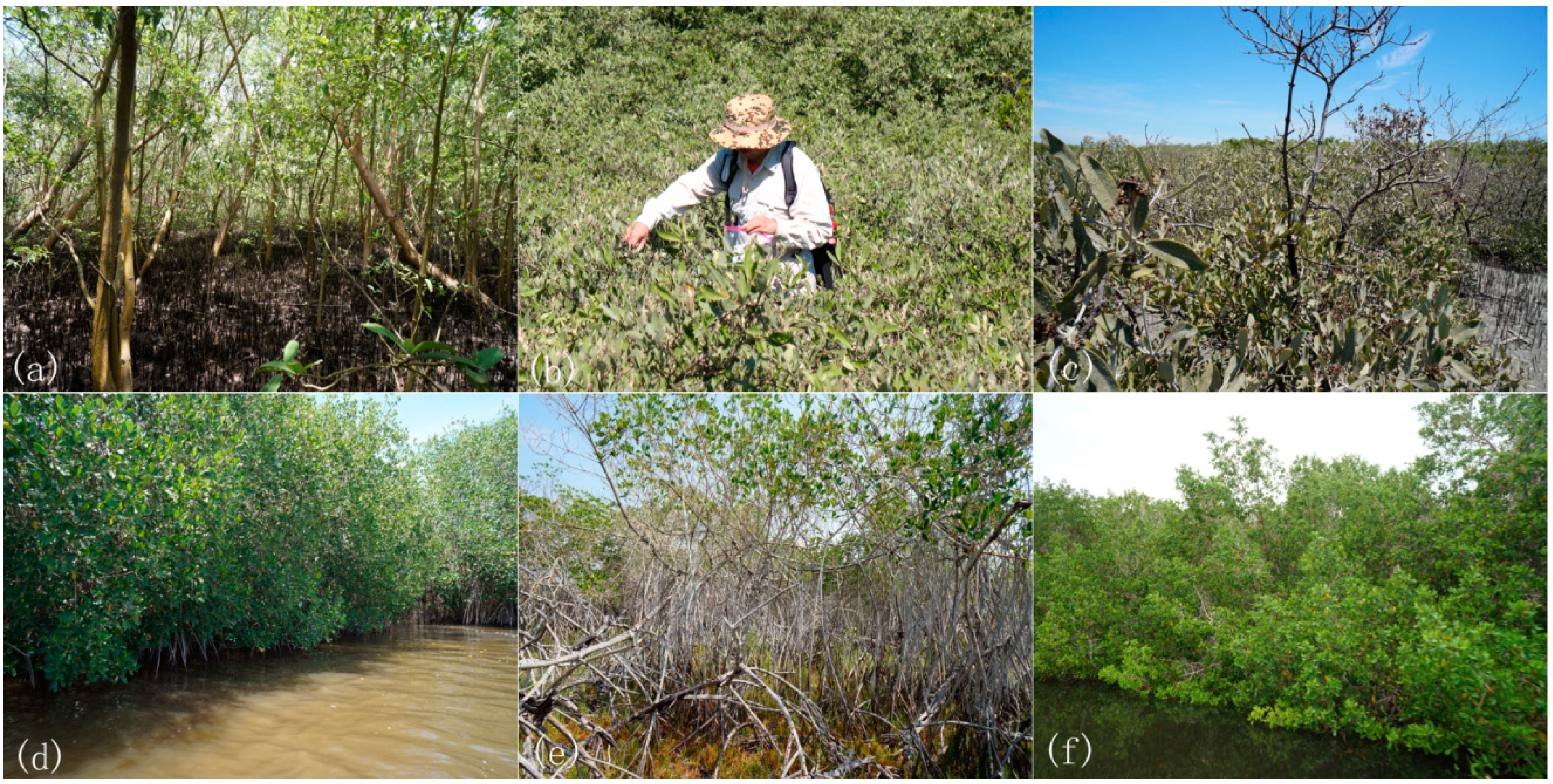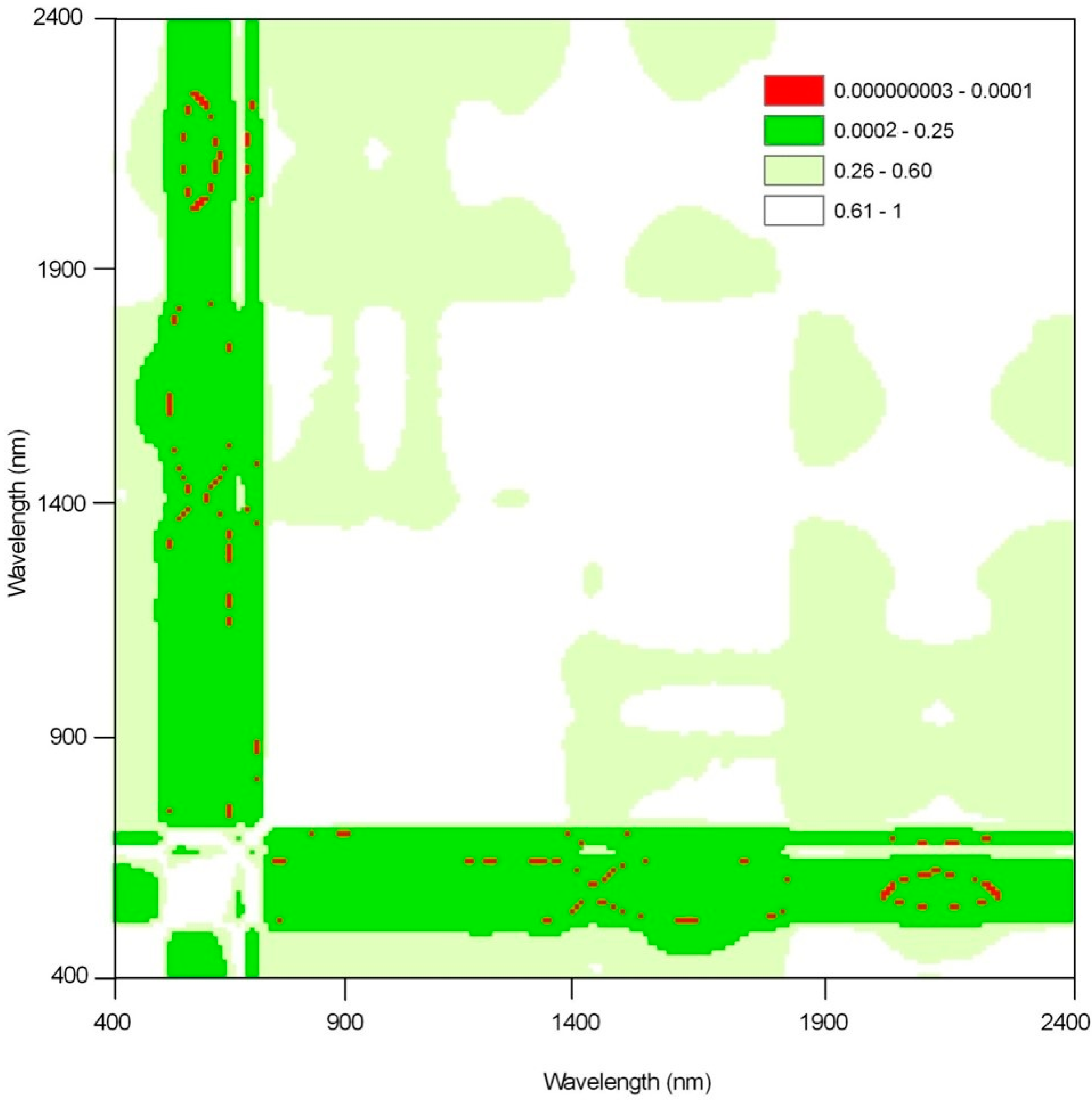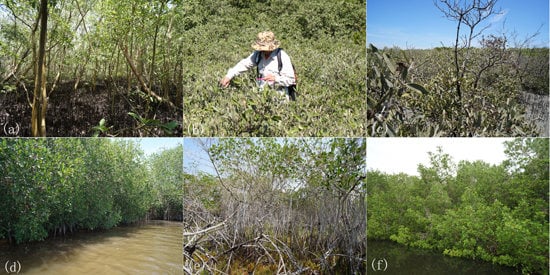Separating Mangrove Species and Conditions Using Laboratory Hyperspectral Data: A Case Study of a Degraded Mangrove Forest of the Mexican Pacific
Abstract
:1. Introduction
2. Study Area

3. Methods
3.1. Field Data Collection
3.2. Spectral Response Measurements and Preprocessing
3.3. Statistical Methods
3.3.1. Waveband Selection
3.3.2. Mangrove Condition Classification and Validation
4. Results and Discussion
4.1. Spectral Properties of Mangrove Species and Conditions


4.2. Wavebands Selection
| Methods | Wavebands Selected (nm) | Notes |
|---|---|---|
| R2 | 520–650, 690–710, 750–770, 830, 890–910, 1170, 1180, 1210–1,230, 1310–1370, 1390–1420, 1440–1490, 1510, 1520, 1550, 1560, 1630, 1640–1670, 1770, 1780, 1830, 1840, 1860, 1870, 2080–2130, 2160–2200, 2220–2240, 2280–2330 | 0.0001 is the cutoff point of correlation |
| PCA | 450–760, 850–940, 1020–1110, 1850–1870, 1920, 1930, 1940, 2110–2270 | PC1 74.84%, PC2 14.13%, PC3 5.43%, PC4 3.15%, PC5 1.22% of variation |
| SDA | 400, 440, 450, 470, 490, 510–570, 600, 630, 650–720, 740, 1000, 1110, 1120, 1140, 1190, 1200, 1290, 1400, 1520, 1630, 1650, 1660, 1710, 1730, 1740, 1780, 1790, 1800, 1840, 1870, 1920, 1960, 2090, 2100, 2140, 2200, 2210, 2230, 2250, 2260 | Entry and stay probability is 0.05 |

| Spectral Region (nm) | Center of Wavebands (nm) | Significance |
|---|---|---|
| 400–690 | 520, 560, 650 | Chlorophyll content |
| 700–1350 | 710, 760 | Red edge/plant stress |
| 1360–1750 | No wavebands selected | - |
| 1760–2340 | 2100, 2230 | Starch, cellulose, protein and nitrogen |

4.3. Mangrove Classification and Validation
| Type | DB | DR | PB | HR | HB | HW | Total | Users’ Accuracy |
|---|---|---|---|---|---|---|---|---|
| DB | 30 | 0 | 0 | 0 | 0 | 0 | 30 | 100% |
| DR | 0 | 30 | 0 | 0 | 0 | 0 | 30 | 100% |
| PB | 2 | 0 | 28 | 0 | 0 | 0 | 30 | 93.33% |
| HR | 0 | 0 | 0 | 30 | 0 | 0 | 30 | 100% |
| HB | 1 | 0 | 1 | 0 | 29 | 0 | 31 | 93.55% |
| HW | 0 | 0 | 0 | 0 | 0 | 30 | 30 | 100% |
| Total | 33 | 30 | 29 | 30 | 29 | 30 | 181 | |
| Producer’s accuracy | 90.91% | 100% | 96.55% | 100% | 100% | 100% |
| Type | DB | DR | PB | HR | HB | HW | Total | Users’ Accuracy |
|---|---|---|---|---|---|---|---|---|
| DB | 26 | 0 | 4 | 0 | 0 | 0 | 30 | 86.67% |
| DR | 0 | 29 | 0 | 1 | 0 | 0 | 30 | 96.67% |
| PB | 3 | 0 | 25 | 0 | 2 | 0 | 30 | 83.33% |
| HR | 0 | 0 | 0 | 30 | 0 | 0 | 30 | 100% |
| HB | 2 | 0 | 2 | 0 | 26 | 1 | 31 | 83.87% |
| HW | 0 | 0 | 0 | 0 | 0 | 30 | 30 | 100% |
| Total | 31 | 29 | 29 | 31 | 28 | 31 | 181 | |
| Producer’s accuracy | 83.87% | 100% | 86.21% | 96.77% | 92.86% | 96.8% |
| Waveband (nm) | 520 | 560 | 650 | 710 | 760 | 2100 | 2230 |
|---|---|---|---|---|---|---|---|
| MSB | 0.00274 | 0.00959 | 0.002211 | 0.035517 | 0.059308 | 0.010197 | 0.014219 |
| MSW | 0.00010 | 0.00022 | 0.000079 | 0.000651 | 0.000759 | 0.000148 | 0.000181 |
5. Conclusions
Acknowledgments
Author Contributions
Conflicts of Interest
References
- Krause, G.; Bock, M.; Weiers, S.; Braun, G. Mapping land cover and mangrove structures with remote sensing techniques: A contribution to a synoptic GIS in support of coastal management in North Brazil. Environ. Manag. 2004, 34, 429–440. [Google Scholar] [CrossRef]
- Kovacs, J.M.; Zhang, C.; Flores-Verdugo, F. Mapping coastal wetland using C-band ENVISAT ASAR and landsat optical data. Cienc. Mar. 2008, 34, 407–418. [Google Scholar]
- Lee, T.; Yeh, H. Applying remote sensing techniques to monitor shifting wetland vegetation: A case study of Danshui River estuary mangrove communities, Taiwan. Ecol. Eng. 2009, 35, 487–496. [Google Scholar] [CrossRef]
- Gao, J. A comparative study on spatial and spectral resolutions of satellite data in mapping mangrove forests. Int. J. Remote Sens. 1999, 20, 2823–2833. [Google Scholar] [CrossRef]
- Green, E.P.; Clark, C.D.; Mumby, P.J.; Edwards, A.J.; Ellis, A.C. Remote sensing techniques for mangrove mapping. Int. J. Remote Sens. 1998, 19, 935–956. [Google Scholar] [CrossRef]
- Jensen, J. R.; Lin, H.; Yang, X.; Ramsey, E., III; Davis, B. A.; Thoemke, C.W. The measurement of mangrove characteristics in southwest Florida using SPOT multispectral data. Geocarto. Int. 1991, 6, 13–21. [Google Scholar] [CrossRef]
- Adam, E.; Mutanga, O.; Rugege, D. Multispectral and hyperspectral remote sensing for identification and mapping of wetland vegetation: A review. Wetl. Ecol. Manag. 2010, 18, 281–296. [Google Scholar] [CrossRef]
- Flores-de-Santiago, F.; Kovacs, J.M.; Flores-Verdugo, F. The influence of seasonality in estimating mangrove leaf chlorophyll-a content from hyperspectral data. Wetl. Ecol. Manag. 2013, 21, 193–207. [Google Scholar] [CrossRef]
- Zhang, C.; Liu, Y.; Kovacs, J.M.; Flores-Verdugo, F.; Flores-Santiago, F.; Chen, K. Spectral response to varying levels of leaf pigments collected from a degraded mangrove forest. J. Appl. Remote Sens. 2012, 6, 1–14. [Google Scholar]
- Zhang, C.; Kovacs, J.M.; Wachowiak, M.P.; Flores-Verdugo, F. Relationship between hyperspectral measurements and mangrove leaf nitrogen concentrations. Remote Sens. 2013, 5, 891–908. [Google Scholar] [CrossRef]
- Hirano, A.; Madden, M.; Welch, R. Hyperspectral image data for mapping wetland vegetation. Wetlands 2003, 23, 436–448. [Google Scholar] [CrossRef]
- Green, E.P.; Mumby, P.J.; Edwards, A.J.; Clark, C.D.; Ellis, A.C. The assessment of mangrove areas using high resolution multispectral airborne imagery. J. Coastal Res. 1998, 14, 433–443. [Google Scholar]
- Held, A.; Ticehurst, C.; Lymburner, L.; Williams, N. High resolution mapping of tropical mangrove ecosystems using hyperspectral and radar remote sensing. Int. J. Remote Sens. 2003, 24, 2739–2759. [Google Scholar] [CrossRef]
- Kamal, M.; Phinn, S. Hyperspectral data for mangrove species mapping: A comparison of pixel-based and object-based approach. Remote Sens. 2011, 3, 2222–2242. [Google Scholar] [CrossRef]
- Jensen, R.; Mausel, P.; Dias, N.; Gonser, R.; Yang, C.; Everitt, J.; Fletcher, R. Spectral analysis of coastal vegetation and land cover using AISA+ hyperspectral data. Geocarto. Int. 2007, 22, 17–28. [Google Scholar] [CrossRef]
- Demuro, M.; Chisholm, L. Assessment of Hyperion for Characterizing Mangrove Communities. Available online: http://url/?q=ftp://popo.jpl.nasa.gov/pub/docs/workshops/03_docs/Demuro_AVIRIS_2003_web.pdf (accessed on 19 August 2014).
- Koedsin, W.; Vaiphasa, C. Discrimination of tropical mangroves at the species level with EO-1 hyperion data. Remote Sens. 2013, 5, 3562–3582. [Google Scholar] [CrossRef]
- Walters, B.B.; Ronnback, P.; Kovacs, J.M.; Crona, B.; Hussain, S.A.; Badola, R.; Primavera, J.H.; Barbier, E.; Dahdouh-Guebas, F. Ethnobiology, socio-economics and management of mangrove forests: A review. Aquat. Bot. 2008, 89, 220–236. [Google Scholar] [CrossRef]
- Hughes, G.F. On the mean accuracy of statistical pattern recognizers. IEEE Trans. Inform. Theory 1968, 14, 55–63. [Google Scholar] [CrossRef]
- Gomez-Chova, L.; Calpe, J.; Camps-Valls, G.; Martin, J.; Soria, E.; Vila, J.; Alonso-Chorda, L.; Moreno, J. Feature selection of hyperspectral data through local correlation and SFFS for crop classification. In Proceedings of IEEE International Geoscience and Remote Sensing Symposium, Toulouse, France, 21–25 July 2003; pp. 555–557.
- Vaiphasa, C.; Skidmore, A.K.; de Boer, W.F.; Vaiphasa, T. A hyperspectral band selector for plant species discrimination. ISPRS J. Photogramm. Remote Sens. 2007, 62, 225–235. [Google Scholar] [CrossRef]
- Zhou, M.D.; Shu, J.O.; Chen, Z.G. Classification of hyperspectral remote sensing image based on genetic algorithm and SVM. Proc. SPIE 2010, 7809. [Google Scholar] [CrossRef]
- Zhuo, L.; Zheng, J.; Wang, F.; Li, X.; Ai, B.; Qian, J. A Genetic Algorithm Based Wrapper Feature Selection Method for Classification of Hyperspectral Images Using Support Vector Machine. Available online: http://en.cnki.com.cn/Article_en/CJFDTOTAL-DLYJ200803004.htm (accessed on 19 August 2014).
- Sreekala, G.B.; Subodh, S.K. Hyperspectral data mining. In Hyperspectral Remote Sensing of Vegetation; Thenkabail, P.S., Lyon, G.J., Huete, A., Eds.; CRC Press: Boca Raton, FL, USA, 2011. [Google Scholar]
- Schmidt, K.S.; Skidmore, A.K. Spectral discrimination of vegetation types in a coastal wetland. Remote Sens. Environ. 2003, 85, 92–108. [Google Scholar] [CrossRef]
- Thenkabail, P.S.; Enclona, E.A.; Ashton, M.S.; van Der Meer, B. Accuracy assessments of hyperspectral waveband performance for vegetation analysis applications. Remote Sens. Environ. 2004, 91, 354–376. [Google Scholar] [CrossRef]
- Vaiphasa, C.; Ongsomwang, S.; Vaiphasa, T.; Skidmore, A.K. Tropical mangrove species discrimination using hyperspectral data: A laboratory study. Estuar. Coast. Shelf. Sci. 2005, 65, 371–379. [Google Scholar] [CrossRef]
- Kamaruzaman, J.; Kasawani, I. Imaging spectrometry on mangrove species identification and mapping in Malaysia. WSEAS Trans. Biol. Biomed. 2007, 8, 118–126. [Google Scholar]
- Mochel, J.; Ponzoni, F.J. Spectral Characterization of Mangrove Leaves in the Brazilian Amazonian Coast: Turiaçu Bay, Maranhão State. Available online: http://www.scielo.br/pdf/aabc/v79n4/a09v79n4.pdf (accessed on 19 August 2014).
- Wang, L.; Sousa, W.P. Distinguishing mangrove species with laboratory measurements of hyperspectral leaf reflectance. Int. J. Remote Sens. 2009, 30, 1267–1281. [Google Scholar] [CrossRef]
- Flores-de-Santiago, F.; Kovacs, J.M.; Flores-Verdugo, F. Seasonal changes in leaf chlorophyll a content and morphology in a sub-tropical mangrove forest of the Mexican Pacific. Mar. Ecol. Prog. Ser. 2012, 444, 57–68. [Google Scholar] [CrossRef]
- Jain, N.; Ray, S.S.; Singh, J.P.; Panigrahy, S. Use of hyperspectral data to assess the effects of different nitrogen applications on a potato crop. Precis. Agric. 2007, 8, 225–239. [Google Scholar] [CrossRef]
- Cliff, N. The eigenvalues-greater-than-one rule and the reliability of components. Psychol. Bull. 1998, 103, 276–279. [Google Scholar] [CrossRef]
- Curran, P.J. Remote sensing of foliar chemistry. Remote Sens. Environ. 1989, 30, 271–278. [Google Scholar] [CrossRef]
- Salovaara, K.J.; Thessler, S.; Malik, R.N.; Tuomisto, H. Classification of Amazonian primary rain forest vegetation using Landsat ETM+ satellite imagery. Remote Sens. Environ. 2005, 97, 39–51. [Google Scholar] [CrossRef]
- Kovacs, J.M.; Liu, Y.; Zhang, C.; Flores-Verdugo, F.; de Santiago, F.F. A field based statistical approach for validating a remotely sensed mangrove forest classification scheme. Wetl. Ecol. Manag. 2011, 19, 409–421. [Google Scholar] [CrossRef]
- Lugo, A.E.; Ernesto, M.; Cuevas, E.; Gilberto, C.; Laboy Nieves, E.N.; Novelli, Y.S. Ecophysiology of a mangrove forest in Jobos Bay, Puerto Rico. Caribb. J. Sci. 2007, 43, 200–219. [Google Scholar]
- Lovelock, C.E.; Bali, M.C.; Choat, B.; Engelbrecht, B.M.J.; Holbrook, N.M.; Feller, I.C. Linking physiological processes with mangrove forest structure: Phosphorus deficiency limits canopy development, hydraulic conductivity and photosynthetic carbon gain in dwarf Rhizophora mangle. Plant Cell. Environ. 2006, 29, 793–802. [Google Scholar] [CrossRef] [PubMed]
- Feller, I.C. Effects of nutrient enrichment on growth and herbivory of dwarf red mangrove (Rhizophora mangle). Ecol. Monogr. 1995, 65, 477–505. [Google Scholar] [CrossRef]
- Flores-de-Santiago, F.; Kovacs, J.M.; Flores-Verdugo, F. Assessing the utility of a portable pocket instrument for estimating seasonal mangrove leaf chlorophyll contents. Bull. Mar. Sci. 2013, 89, 621–633. [Google Scholar] [CrossRef]
- Blackmer, T.M.; Schepers, J.S.; Varvel, G.E.; Walter-Shea, E.A. Nitrogen deficiency detection using reflected shortwave radiation from irrigated corn canopies. Agron. J. 1996, 88, 1–5. [Google Scholar] [CrossRef]
- Carter, G.A.; Miller, R.L. Early detection of plant stress by digital imaging within narrow stress-sensitive wavebands. Remote Sens. Environ. 1994, 50, 295–302. [Google Scholar] [CrossRef]
- Carter, G.A.; Knapp, A.K. Leaf optical properties in higher plants: Linking spectral characteristics to stress and chlorophyll concentration. Am. J. Bot. 2001, 88, 677–684. [Google Scholar] [CrossRef] [PubMed]
© 2014 by the authors; licensee MDPI, Basel, Switzerland. This article is an open access article distributed under the terms and conditions of the Creative Commons Attribution license (http://creativecommons.org/licenses/by/4.0/).
Share and Cite
Zhang, C.; Kovacs, J.M.; Liu, Y.; Flores-Verdugo, F.; Flores-de-Santiago, F. Separating Mangrove Species and Conditions Using Laboratory Hyperspectral Data: A Case Study of a Degraded Mangrove Forest of the Mexican Pacific. Remote Sens. 2014, 6, 11673-11688. https://doi.org/10.3390/rs61211673
Zhang C, Kovacs JM, Liu Y, Flores-Verdugo F, Flores-de-Santiago F. Separating Mangrove Species and Conditions Using Laboratory Hyperspectral Data: A Case Study of a Degraded Mangrove Forest of the Mexican Pacific. Remote Sensing. 2014; 6(12):11673-11688. https://doi.org/10.3390/rs61211673
Chicago/Turabian StyleZhang, Chunhua, John M. Kovacs, Yali Liu, Francisco Flores-Verdugo, and Francisco Flores-de-Santiago. 2014. "Separating Mangrove Species and Conditions Using Laboratory Hyperspectral Data: A Case Study of a Degraded Mangrove Forest of the Mexican Pacific" Remote Sensing 6, no. 12: 11673-11688. https://doi.org/10.3390/rs61211673
APA StyleZhang, C., Kovacs, J. M., Liu, Y., Flores-Verdugo, F., & Flores-de-Santiago, F. (2014). Separating Mangrove Species and Conditions Using Laboratory Hyperspectral Data: A Case Study of a Degraded Mangrove Forest of the Mexican Pacific. Remote Sensing, 6(12), 11673-11688. https://doi.org/10.3390/rs61211673






